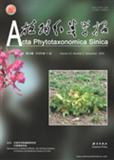1ZHANG Shou-Gong, 2CHEN Cheng-Bin, 1HAN Su-Ying, 2LI Xiu-Lan, 3REN Jian-Zhong, 3ZHOU Yu-Quan, 2SONG Wen-Qin, 2CHEN Rui-Yang, 1QI Li-Wang*
2005, 43 (6): 539–544
Chromosome numbers and ploidy levels of 14 Chinese Populus species (Populus alba L., P. hopeiensis Hu & Chow, P. tomentosa Carr., P. tremula L., P. simonii Carr., P. maximowiczii Henry, P. ussuriensis Kom., P. cathayana Rehd., P. pseudo-simonii Kitag., P. koreana Rehd., P. trichocarpa Torr. & Grog., P. lasiocarpa Oliv., P. nigra L., P. euphratica Oliv.), three varieties (P. alba L. var. pyramidalis Bge., P. nigra L. var. thevestina Bean., P. nigra L. var. italica (moench.) Koehne) and three hybrid species (P. ×xiaozhuanica W. Y. Hsu & Liang, P. ×beijingensis W. Y. Hsu, P. ×canadensis Moench, P. ×canadensis Moench cv. “serotina”, P. ×canadensis Moench cv. “Sacrau 79”, P. ×canadensis Moench cv. “I-214”) are reported. These taxa represent five sections of the genus. P. tomentosa of section Populus and P. ×canadensis Moench cv. “Sacrau 79”, P. × canadensis Moench cv. “I-214” of section Aigeiros were triploid (2n=2x=38), while the remaining taxa were diploid (2n=2x=38).










